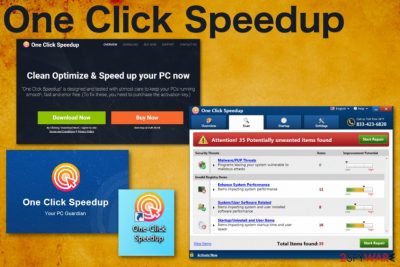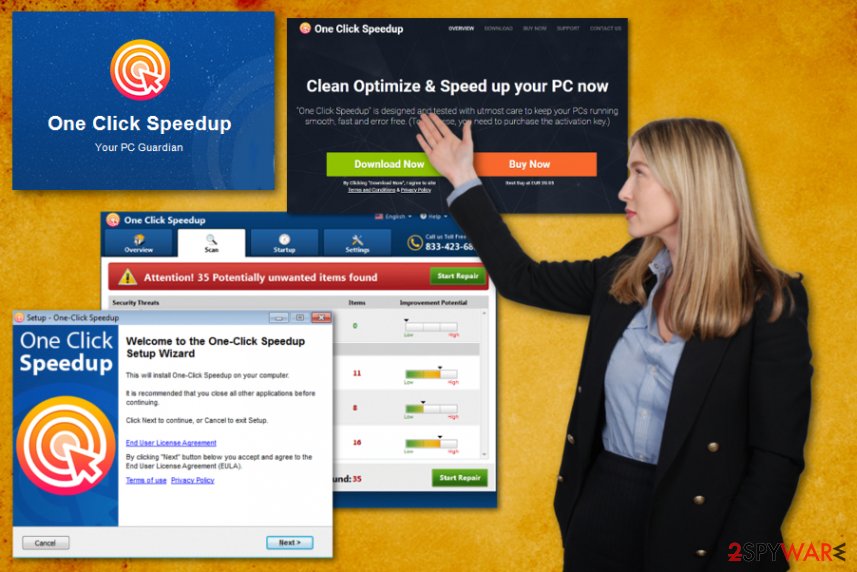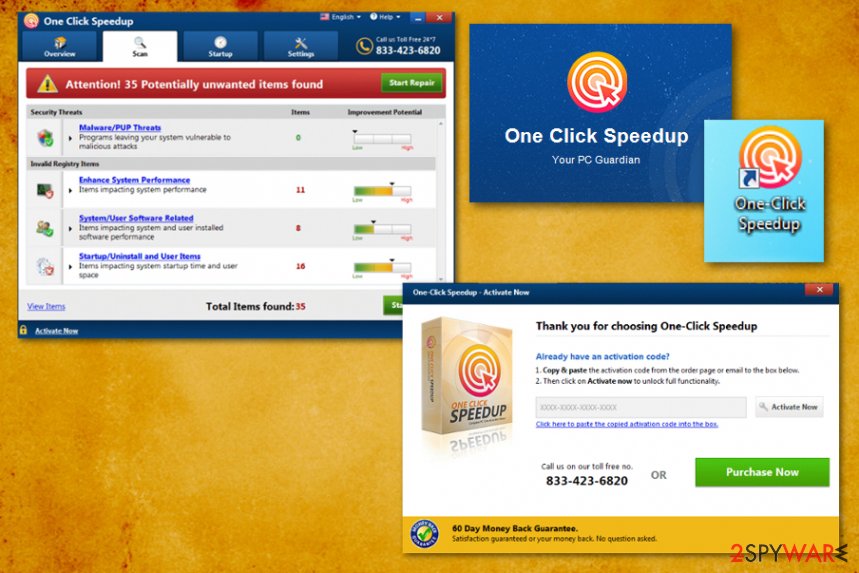One Click Speedup (Free Instructions) - Removal Guide
One Click Speedup Removal Guide
What is One Click Speedup?
One Click Speedup is a system optimizer which claims that several issues with your device were detected after a supposed PC scan

One Click Speedup is the rogue tool that is advertised as your PC guardian. However, this is a potentially unwanted program that shows false positive results of a system scan to convince people that the machine is infected or has other problems that require fixing. Developers of this program claim to offer system optimization, cleaning services, and speed up the performance of your PC. Once the system check is performed on your machine and the tool detects possible errors, you need to purchase the activation key for 35,95 euro to get the full version of the software, that can fix all the issues and clean malware activated.
Nevertheless, the full version of One Click Speedup rogue software also does nothing positive for the machine. It only cleans the list and eliminates all those pre-determined scan results stating about particular intruders or system errors.[1] You shouldn't trust any of these claims and avoid even installing the tool from promotional advertisements or even the official sites belonging to PCVARK – developers of many other PUPs.
| Name | One Click Speedup |
|---|---|
| Type | Rogue system optimizer |
| Category | Potentially unwanted program |
| Developer | PCVARK |
| Other similar tools | |
| Symptoms | Shows pre-determined scan results with various issues that require fixing, and malware detections |
| Price | 39,95 euro |
| Distribution | Deceptive promotions, websites, other malware, freeware bundling |
| Elimination | Install reliable anti-malware tool and remove One Click Speedup |
One Click Speedup virus gets this name because of the unwanted and suspicious activity when it appears on the machine out of nowhere and starts showing information about the possible danger or damage. Microsoft even has an opinion about such tools since programs like that often affect registry entries and can cause more damage than the pre-determined scans show.[2]
The main goal of the tool is to convince users that their device has problems, malware, and other issues because the full OneClickSpeedup version can allegedly fix them all and improve the general performance of the PC. Unfortunately, even the pricy version of the optimizer cannot fix real issues with the machine.
One Click Speedup PUP not only comes to the machine without permission, but the tool also loads the shortcut icon on the desktop, start menu, and pins the program in your taskbar. These steps are needed to ensure the difficult elimination and uninstallation process. Users always complain that the tool is persistent and annoying because of these features alone.
OneClickSpeedup is promoted on the internet, via various promotional content like any other product from PCVARK, so people can even download this tool on purpose. During the installation, people should notice red flags and other PUPs included in the setup. This is the main feature that determines the questionable purposes of the tool.

Unfortunately, One Click Speedup tool tricks many people into installing the program and even purchasing the activation key for the licensed version. When the software has its own official download page, it seems to be legitimate and safe. Not in this case.
One Click Speedup is only one of many system optimizers that claim to offer all those features of system cleaning, registry entry organizing, and malware termination. All those issues are fake, and probably the only cyber infection your PC has is the main PUP causing all the unwanted commercial content.
Since this tool is nothing but a potentially unwanted application, One Click Speedup can access and track data regarding your online preferences or browsing history. This is a common feature of all these programs because the main sponsors and distributors are advertisers.
When your device gets affected by such a tool, every click on the redirect or a pop-up generates views and revenue for the ad-supported page. One Click Speedup removal should be performed as soon as possible, so this data recording ends before any personal data gets accessed.
You can remove One Click Speedup by uninstalling the tool itself from the machine, but that doesn't ensure that all the intrusive behavior ends. So we as any other expert[3] recommend using automatic antivirus tools like FortectIntego or SpyHunter 5Combo Cleaner and scanning the machine thoroughly.

Fake system tools come as an additional part of the freeware installation setup
Even when you download the program from the official and legitimate-looking website, you can risk getting the potentially unwanted program or a suspicious tool alongside the program you intended to get. You should always read the EULA or Privacy Policy section of the website to make sure that the distributor is reliable.
Also, opting for Advanced or Custom installations allows you to see all included and possibly bundled programs and remove unwanted ones from the list. You should do this every time you install anything on the machine, no matter the source or developer to ensure that the device remains virus-free.
You need to eliminate One Click Speedup virus and employ reliable tools for the process
Unfortunately, One Click Speedup removal is not that easy as it may seem, especially when you try to get rid of the potentially unwanted application manually. This method is not advisable because you cannot find all the associated programs, files, and browser extensions. However, you need to delete all the related material to end the malicious processes.
We offer to go for the automatic One Click Speedup removal method and use anti-malware tools. A full system scan that such a program can perform on the PC indicates various issues with the computer and detects malware. Once the malicious program is detected, you can easily delete that from the system. Keeping tools like that can also help to avoid cyber infections in the future because AV tools can block PUPs and malicious pages before visiting or installing them.
You may remove virus damage with a help of FortectIntego. SpyHunter 5Combo Cleaner and Malwarebytes are recommended to detect potentially unwanted programs and viruses with all their files and registry entries that are related to them.
Getting rid of One Click Speedup. Follow these steps
Uninstall from Windows
Users should clean the system fully to remove One Click Speedup PUP
Instructions for Windows 10/8 machines:
- Enter Control Panel into Windows search box and hit Enter or click on the search result.
- Under Programs, select Uninstall a program.

- From the list, find the entry of the suspicious program.
- Right-click on the application and select Uninstall.
- If User Account Control shows up, click Yes.
- Wait till uninstallation process is complete and click OK.

If you are Windows 7/XP user, proceed with the following instructions:
- Click on Windows Start > Control Panel located on the right pane (if you are Windows XP user, click on Add/Remove Programs).
- In Control Panel, select Programs > Uninstall a program.

- Pick the unwanted application by clicking on it once.
- At the top, click Uninstall/Change.
- In the confirmation prompt, pick Yes.
- Click OK once the removal process is finished.
Delete from macOS
Remove items from Applications folder:
- From the menu bar, select Go > Applications.
- In the Applications folder, look for all related entries.
- Click on the app and drag it to Trash (or right-click and pick Move to Trash)

To fully remove an unwanted app, you need to access Application Support, LaunchAgents, and LaunchDaemons folders and delete relevant files:
- Select Go > Go to Folder.
- Enter /Library/Application Support and click Go or press Enter.
- In the Application Support folder, look for any dubious entries and then delete them.
- Now enter /Library/LaunchAgents and /Library/LaunchDaemons folders the same way and terminate all the related .plist files.

Remove from Microsoft Edge
Delete unwanted extensions from MS Edge:
- Select Menu (three horizontal dots at the top-right of the browser window) and pick Extensions.
- From the list, pick the extension and click on the Gear icon.
- Click on Uninstall at the bottom.

Clear cookies and other browser data:
- Click on the Menu (three horizontal dots at the top-right of the browser window) and select Privacy & security.
- Under Clear browsing data, pick Choose what to clear.
- Select everything (apart from passwords, although you might want to include Media licenses as well, if applicable) and click on Clear.

Restore new tab and homepage settings:
- Click the menu icon and choose Settings.
- Then find On startup section.
- Click Disable if you found any suspicious domain.
Reset MS Edge if the above steps did not work:
- Press on Ctrl + Shift + Esc to open Task Manager.
- Click on More details arrow at the bottom of the window.
- Select Details tab.
- Now scroll down and locate every entry with Microsoft Edge name in it. Right-click on each of them and select End Task to stop MS Edge from running.

If this solution failed to help you, you need to use an advanced Edge reset method. Note that you need to backup your data before proceeding.
- Find the following folder on your computer: C:\\Users\\%username%\\AppData\\Local\\Packages\\Microsoft.MicrosoftEdge_8wekyb3d8bbwe.
- Press Ctrl + A on your keyboard to select all folders.
- Right-click on them and pick Delete

- Now right-click on the Start button and pick Windows PowerShell (Admin).
- When the new window opens, copy and paste the following command, and then press Enter:
Get-AppXPackage -AllUsers -Name Microsoft.MicrosoftEdge | Foreach {Add-AppxPackage -DisableDevelopmentMode -Register “$($_.InstallLocation)\\AppXManifest.xml” -Verbose

Instructions for Chromium-based Edge
Delete extensions from MS Edge (Chromium):
- Open Edge and click select Settings > Extensions.
- Delete unwanted extensions by clicking Remove.

Clear cache and site data:
- Click on Menu and go to Settings.
- Select Privacy, search and services.
- Under Clear browsing data, pick Choose what to clear.
- Under Time range, pick All time.
- Select Clear now.

Reset Chromium-based MS Edge:
- Click on Menu and select Settings.
- On the left side, pick Reset settings.
- Select Restore settings to their default values.
- Confirm with Reset.

Remove from Mozilla Firefox (FF)
Remove dangerous extensions:
- Open Mozilla Firefox browser and click on the Menu (three horizontal lines at the top-right of the window).
- Select Add-ons.
- In here, select unwanted plugin and click Remove.

Reset the homepage:
- Click three horizontal lines at the top right corner to open the menu.
- Choose Options.
- Under Home options, enter your preferred site that will open every time you newly open the Mozilla Firefox.
Clear cookies and site data:
- Click Menu and pick Settings.
- Go to Privacy & Security section.
- Scroll down to locate Cookies and Site Data.
- Click on Clear Data…
- Select Cookies and Site Data, as well as Cached Web Content and press Clear.

Reset Mozilla Firefox
If clearing the browser as explained above did not help, reset Mozilla Firefox:
- Open Mozilla Firefox browser and click the Menu.
- Go to Help and then choose Troubleshooting Information.

- Under Give Firefox a tune up section, click on Refresh Firefox…
- Once the pop-up shows up, confirm the action by pressing on Refresh Firefox.

Remove from Google Chrome
Make sure to clean the browser from additional content installed by the intruder
Delete malicious extensions from Google Chrome:
- Open Google Chrome, click on the Menu (three vertical dots at the top-right corner) and select More tools > Extensions.
- In the newly opened window, you will see all the installed extensions. Uninstall all the suspicious plugins that might be related to the unwanted program by clicking Remove.

Clear cache and web data from Chrome:
- Click on Menu and pick Settings.
- Under Privacy and security, select Clear browsing data.
- Select Browsing history, Cookies and other site data, as well as Cached images and files.
- Click Clear data.

Change your homepage:
- Click menu and choose Settings.
- Look for a suspicious site in the On startup section.
- Click on Open a specific or set of pages and click on three dots to find the Remove option.
Reset Google Chrome:
If the previous methods did not help you, reset Google Chrome to eliminate all the unwanted components:
- Click on Menu and select Settings.
- In the Settings, scroll down and click Advanced.
- Scroll down and locate Reset and clean up section.
- Now click Restore settings to their original defaults.
- Confirm with Reset settings.

Delete from Safari
Remove unwanted extensions from Safari:
- Click Safari > Preferences…
- In the new window, pick Extensions.
- Select the unwanted extension and select Uninstall.

Clear cookies and other website data from Safari:
- Click Safari > Clear History…
- From the drop-down menu under Clear, pick all history.
- Confirm with Clear History.

Reset Safari if the above-mentioned steps did not help you:
- Click Safari > Preferences…
- Go to Advanced tab.
- Tick the Show Develop menu in menu bar.
- From the menu bar, click Develop, and then select Empty Caches.

After uninstalling this potentially unwanted program (PUP) and fixing each of your web browsers, we recommend you to scan your PC system with a reputable anti-spyware. This will help you to get rid of One Click Speedup registry traces and will also identify related parasites or possible malware infections on your computer. For that you can use our top-rated malware remover: FortectIntego, SpyHunter 5Combo Cleaner or Malwarebytes.
How to prevent from getting system tools
Access your website securely from any location
When you work on the domain, site, blog, or different project that requires constant management, content creation, or coding, you may need to connect to the server and content management service more often. The best solution for creating a tighter network could be a dedicated/fixed IP address.
If you make your IP address static and set to your device, you can connect to the CMS from any location and do not create any additional issues for the server or network manager that needs to monitor connections and activities. VPN software providers like Private Internet Access can help you with such settings and offer the option to control the online reputation and manage projects easily from any part of the world.
Recover files after data-affecting malware attacks
While much of the data can be accidentally deleted due to various reasons, malware is one of the main culprits that can cause loss of pictures, documents, videos, and other important files. More serious malware infections lead to significant data loss when your documents, system files, and images get encrypted. In particular, ransomware is is a type of malware that focuses on such functions, so your files become useless without an ability to access them.
Even though there is little to no possibility to recover after file-locking threats, some applications have features for data recovery in the system. In some cases, Data Recovery Pro can also help to recover at least some portion of your data after data-locking virus infection or general cyber infection.
- ^ Josh Smith. Fake System Optimization Tools Use Fear to Scam Consumers. AOL. News and entertainment.
- ^ Microsoft support policy for the use of registry cleaning utilities. Microsoft. Windows support community.
- ^ Losvirus. Losvirus. Spyware related news.























